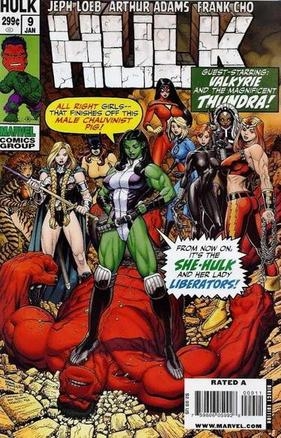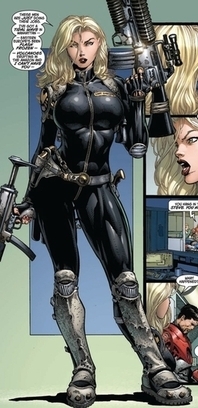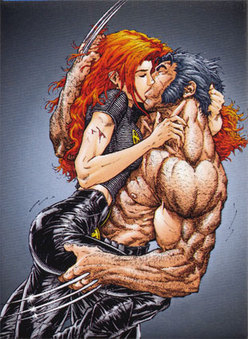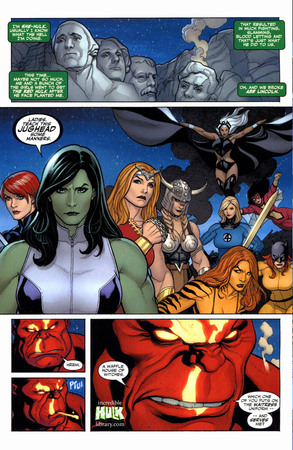Comics /
Spotlight
Comic Books and Responsibility
By Zak Edwards
March 3, 2009 - 15:48
Something has been bothering me for quite some time now and I think this statement is the best way to set-up this article. I am bothered by some problems the comic book industry is facing and how these problems are not ones going away or even acknowledged by the majority of readers. The idea of what we, as consumers of the comic book and graphic novel medium, are supporting in terms of what is appropriate and what is inappropriate when it comes to the products we support is this problem. In a capitalist society especially, what is bought is what is made, so what is being made becomes a reflection of the society driving these products. This brings me to a serious problem within the comic book industry.
 |
| The cover being honoured here is Avengers #83 from the 1970's. |
I would like to point out at this time I am focusing on the most popular comic books produced, not the vast amounts of work done within graphic literature which deserves that pretentious title. I am aware of great works like
Maus,
American Splendor,
Blankets, the work of R. Crumb, and the countless other titles and creators that draw inspiration and ideas from outside what the biggest selling titles are and contribute to the growing recognition of graphic literature as an important medium. But for the purpose of this article, I am focusing on what constitutes the vast majority of comic books purchased: those produced by Marvel Comics, DC Comics, Image Comics, and Dark Horse Comics (with a special emphasis on the super-hero genre in its many forms. These companies represent about eighty to ninety percent of total sales in North America of comic books, which is a giant amount. Arguably an unstoppable force within comic books.
I would also like to point out the majority of my articles are reviews of Marvel Comics’ books. Many of these I review because I enjoy them, I value escapist literature and do look to comic books as a form of entertainment, but also because they are articles that are read and numbers are very, very important, both to me and my boss. So in a way I am part of the problem, even more so than an average reader because I am giving a comic book even more exposure through writing an article on it.
But let’s look at the top sales for the month of December, the latest month on Diamond Comic Distributors website as of writing this. They are as follows:
1.
Secret Invasion #8
2.
Final Crisis #5
3.
Secret Invasion Dark Reign
4.
New Avengers #47
5.
New Avengers #48
6.
Batman #682
7.
Batman #683
8.
Hulk #9
9.
Mighty Avengers #20
10.
Ultimatum #2
On first glance, this looks fairly stereotypical to me. Marvel Comics enjoys the majority of the spots with seven while DC Comics makes up the remaining three. Brian Michael Bendis’ work secures four of the titles as well. Major events of the time, Final Crisis, Secret Invasion and Dark Reign, Ultimatum, Batman R.I.P, and their respective tie-ins are represented in every book save for a debatable Hulk #9. So, in a nutshell, as consumers, the comic book buying public enjoys the big events (or feels obligated to follow them) and work by well established writers like Brian Michael Bendis, Jeph Loeb, and Grant Morrison, all who have proven their abilities in past or current works despite the generally low critical reaction to the specific titles on the top ten. It is a generally accepted notion that writers have bigger followings than artists, not to say artists do not have followings as made example by works like the recent Wonderful World of Oz adaptation drawn by Skottie Young, the late Michael Turner’s extremely popular variant covers, or Frank Cho’s work in female-heavy comic books.
So let’s look at what artistic styles we are looking at for the top ten. Artists include Brian Finch, Alex Maleev, Leinil Francis Yu, Frank Cho, Billy Tan, Alex Ross, and J.G Jones, all of whom are either fairly established within the medium or very famous and all have extensive resumes within comic books, most notably with Marvel and DC Comics. All the covers, save for a possible argument for Batman #682, have the usual: impossibly exaggerated anatomies of both men and women. The DC Comics covers are less so than most of the Marvel Comics books, especially those of Hulk #9, Secret Invasion Dark Reign, and Ultimatum #2 which all have a very big focus on hyper-exaggeration of the female form especially. But sex sells, it isn’t a cliched saying, it’s the truth and everyone knows it, and I hardly need to come up with examples for that. One of the goals of this article is to question this cliche as this medium above any other has serious issue involved with the sexuality depicted. But I would like to take a closer look at a couple of titles in particular, that being Hulk #9 and Ultimatum #2. Both have received extremely negative criticism from multiple reviewers (including right here at the Bin), and both are also blatantly offensive, especially Hulk #9.
Now this may appear to be picking on Jeph Loeb, the writer of both books, but these titles epitomize the top ten, either being part of an event, written by a superstar and illustrated by a well-known artist, and both are books published by Marvel Comics, which is also a common theme amongst the majority of books. But they also tell something else about our buying habits which we should be ashamed of as a demographic and as consumers.
 |
Ultimatum #2 is a poorly written and is basically an excuse to have Brian Finch work his ‘magic,’ which is to parade impossibly proportioned characters around in very little clothing. Probably the best display of this is the single panel of Carol Danvers with breasts as big as her head holding two guns in a hospital. The panel exists solely to further up the sex appeal of the book. Similar scenes involving a personification of Death occurs later in the book, which is heavily S & M and equally overtly sexual. The over-sexualization is not exclusive to the females, as the male characters also possess similar exaggerations. This hyper-exaggeration causes me to think of Joe Quesada’s famous decision to ban smoking in Marvel books because of the impact of depicting characters smoking on younger readers buying the comic books. Of course, this sort of decision is possibly a good one as the books are frequently read by younger readers and the books are targeting a teenage, white, male, middle-class demographic (like most everything). But this censorship points to one thing for me, and that is the self-recognized impact Marvel Comics has on developing minds. Quesada is willing to recognize this and make changes specifically to something both popular right now and personally affecting (His father died from lung cancer as a result of smoking), but not other aspects of these books which are impacting younger readers on gender are largely ignored.
 |
This picture on the left, for example, seems to display the epitomizing of the bisexual and hyper-sexual nature of comic books in the top ten. As you can see, the picture is one of a kiss between Jean Grey and Wolverine of the X-Men (which is from Uncanny
X-Men #394, June 2001, art by Ian Churchill). But what does this communicate in terms of masculinity to the target demographic? Some context to the picture would tell us Jean Grey is married to someone else, Scott Summers specifically, and despite this, a man like Wolverine is still able to obtain sexual gratification. He is able to get this because Wolverine is traditionally depicted as falling into many masculine stereotypes. He is tough, short on words and big on action, willing to do what is necessary, likes beer and cars, and also has a significant amount of martial prowess, which is very much a traditional aspect to masculinity, dating back to early mythology. Also, in simple terms of anatomy, Wolverine’s arm is bigger than Jean Grey’s waist, which is forcing masculinity and femininity into very specific body-types. Women, skinny with ample cleavage, men, impossibly gigantic muscles (if you look closely, Wolverine’s arms are a little bigger than his legs). Through both the anatomy and characterization of its characters, Marvel Comics is reinforcing stereotypes of what men and women are and should be. I find this hypocritical approach to censorship within Marvel Comics products to be unnerving. Jumping on a bandwagon debate like anti-smoking and claiming a personal and societal responsibility towards their depiction within in comic books, while leaving a more pressing and socially fundamental issue like gender to fantasy and stereotype is, unfortunately, making the former insincere and as much a move to garner attention and sales as the latter.
Hulk #9 is possibly the most offensive, misogynistic, and blatantly pathetic comic book I have read in a very long time and possibly ever. This may come across as melodramatic, but the issue is offensive, almost ironically so. The cover, a throwback to an Avengers issue from the seventies, depicts a victorious She-Hulk standing on top of an unconscious Red Hulk and surrounded by about eight female super heroes. The speech bubble coming from She-Hulk declares “All Right Girls-- That Takes Care of That Male Chauvinist Pig!” Of course, the Red Hulk does happen to be fairly chauvinistic in this issue and is the villain, so this works. Unfortunately, both of the major creators happen to be quite misogynistic themselves, and the cover then only serves to point out the self-perpetuation of outdated and now offensive ideals. Let’s start with the artist of the story, Frank Cho. Cho belongs to a long line of comic book illustrators who literally make a
 |
| This picture does not fully exemplify what I am trying to discuss, but it was the only interior art I could find. Take note of Red Hulk's wonderful scripting! |
living off of their exaggerated depictions of characters, particularly women. I do not feel a need to list any, but we all know they are out there. I remember last year Marvel Comics had a page in every one of their issues one week asking male creators which Marvel character they were most attracted to and one creator (I forget who) stated any character drawn by Frank Cho. Cho also released a book entitled “Women,” which claims to prove he is “one of the top modern masters of the female form” (taken from a solicitation for the book found on the website for the Canadian bookstore chain Chapters), but his hardly accounts for a mastery of anatomy, but rather the ability to sexually stimulate through gross exaggeration. His art within the book is fairly offensive beyond the usual skin-tight, barely-there costuming choices. Most of the panels featuring a character breaking out of the confines of the panel and running into the gutter are to feature either the breasts or backsides of the female characters who are fighting the Red Hulk. This happens about three times in the short story, probably the worst being a panel depicting all the characters desperately searching for a cell phone which is ringing. Besides all of the costumes which could in no way contain a cell phone, Cho graces his audience with a shot of Storm from behind coming out of the panel and displaying for certain Storm could not have the phone as she is not wearing pants, perhaps it could be in her cape somewhere.
As for the writing of Hulk #9, Jeph Loeb proves the cover of this book as not satirical, but perpetuating a sexist message. The female characters do overcome the Red Hulk initially, only to discover he was faking in order to grab hold of one of them after the fight. The inner monologue of the She-Hulk during the fight contains such cliched lines like, “You think it’s hard being a superhero, try doing it as a woman,” which only undermines the feminist movement and thinking by relying on these overtly old and tired arguments. The statement reduces much of what She-Hulk is saying to cliche, which in turn moves her argument from legitimate to mockery and through this mockery, a joke. But after the fight is over, the story continues along these lines. Immediately after the characters think they have defeated their adversary, mindless idle chatter begins. Two characters begin gossiping about Tony Stark and who hasn’t slept with him, another begins complaining about jokes made towards them. Only the most masculine looking characters, the She-Hulk and Thundara, actually try to come to some sort of conclusion on what to do with Red Hulk. This in itself causes problems, suggesting female characters have to adopt male characteristics in order to be in control of a situation. The irony is, even when they are attempting to be in control, the male character playing possum and wrapped up in chains is still in ultimate control of the situation. I have heard the argument for satire, but the satire present here, if it is intended to be as such, is lost because of a lack of argument. For satire to work, there has to be a condemnation, a call of attention to something wrong and, however covered up, a call for change and action. By selecting artists who perpetuate the objectification of the female body while infusing it with blatantly anti-feminist writing, Hulk #9 is not satirical, it is a throwback and nostalgic look at a time where this sort of writing was acceptable. Now, this writing is offensive and disregarding some major social developments in the world. I other words, Loeb is expressing a want for a world we should be looking back at as restricting and backwards, but instead he is upholding these outdated values. Overall, the story is not only offensive, but proves to be misogynistic and thus making the cover not only deeply ironic, but depicts the comic book industry, the popular ones especially, as stunted and flattened works of pulp fiction not deserving any serious study.
This article is hardly original. The condemnation of the art in popular comic books is something which has been studied by much smarter and more accomplished people than I. The problems presented in the top ten comics are also hardly exclusive to comic books either. Certainly many of these arguments could be translated over to magazines, films, television or certainly any other form of popular culture medium. But I also believe comic books are at a crucial step in their development as a medium. More and more comic books are showing up on university book lists, getting more attention in more legitimate mediums, but at the same time garnering a continued public perception of largely being, as Scott McCloud put it, “semiliterate, cheap, disposable kiddie fare.” Are super hero comics really that different from most thirty years ago, even after the impact of books like
Watchmen? If one is to look at the best selling comic books, the industry is stagnate, offensive, and certainly not innovative. So I am questioning what we, as consumers and supporters of the comic book industry, are buying. I am certainly not telling you what to buy, I know the value some escapism can have and do encourage comic books which allow for this, but I am asking you to think about what you support with your money. I, for one, am stating a pact with myself to not buy books with contributions by the artistic team behind Hulk #9 from now on because I do not believe this sort of text should be encouraged. Of course, I do have to finish my reviews of the Ultimatum, as promised, but following this, I am making a personal choice not to support these artists on grounds of offensive material. I encourage you to do the same.
Last Updated: March 3, 2025 - 20:40



